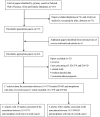Relevance of LIG4 gene polymorphisms with cancer susceptibility: evidence from a meta-analysis
- PMID: 25314918
- PMCID: PMC4197418
- DOI: 10.1038/srep06630
Relevance of LIG4 gene polymorphisms with cancer susceptibility: evidence from a meta-analysis
Abstract
Polymorphisms of LIG4 gene may influence DNA repair ability, thus altering the genetic stability and resulting in carcinogenesis. A growing number of studies have investigated the relevance of LIG4 T9I (rs1805388) and D501D (rs1805386) polymorphisms with cancer risk, however, the results are conflicting. To obtain a comprehensive conclusion, we searched relevant literatures from PubMed, Web of Science, Ovid and Embase databases on May 15, 2014 and performed a meta-analysis. In this meta-analysis, a total of 17 articles were included. Of them, there were 15 studies with 5873 cases and 5771 controls for rs1805388 and 6 studies with 4161 cases and 4881 controls for rs1805386. Overall, our results suggested that there was no obvious relevance of LIG4 T9I polymorphism with cancer susceptibility. However, in subgroup analysis, we found the LIG4 T9I was associated with a slightly decreased cancer risk among Caucasians. As to the rs1805386, the genetic variant had no significant association with cancer risk. In conclusion, despite several limitations, this meta-analysis suggested that LIG4 T9I genetic variant is associated with a decreased risk of cancer among Caucasians, however, the rs1805386 gene polymorphism is not a risk factor of cancer.
Figures



References
-
- Carter D. New global survey shows an increasing cancer burden. Am J Nurs 114, 17 (2014). - PubMed
-
- Popat K., McQueen K. & Feeley T. W. The global burden of cancer. Best Pract Res Clin Anaesthesiol 27, 399–408 (2013). - PubMed
-
- Siegel R., Ma J., Zou Z. & Jemal A. Cancer statistics, 2014. CA Cancer J Clin 64, 9–29 (2014). - PubMed
-
- Wilson, S., Jones, L., Coussens, C. & Hanna, K. (Eds.). Cancer and the environment: Gene–environment interaction, (National Academy Press, Washington, DC, 2002). - PubMed
Publication types
MeSH terms
Substances
LinkOut - more resources
Full Text Sources
Other Literature Sources
Research Materials

